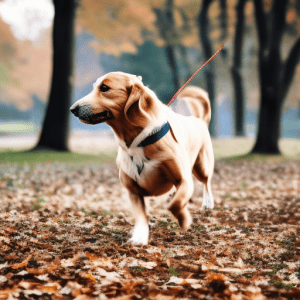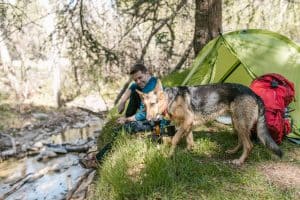Going on a hike can be a great adventure for both humans and their furry companions. Taking your puppy on its first hike is an exciting experience that can help strengthen the bond between the two of you. Not only will it be a fun outdoor activity, but it will also give your pup a chance to explore new sights, smells, and sounds in an environment outside of its home.
While there are some additional considerations to take when preparing to take a puppy on a hike, with the right planning and precautions, it can be an enjoyable experience for both you and your pup. In this article, we’ll explore how to properly prepare for your puppy’s first hike, so you can hit the trails together worry-free.
Preparing for your puppy’s first hike
A. Appropriate gear for puppies
When preparing to take your new puppy on its first hike, it is important to think about what kind of gear you need to make sure they remain safe and comfortable.
A comfort-fitting harness with a sturdy leash is the perfect choice for puppies as their size can easily be adjusted and ensure that they won’t slip out of the harness while out and about.
Look for a backpack or carrier that fits your pup if you choose to carry them: it should have adjustable straps, waterproof material, plenty of ventilation, and a well-padded bottom for added comfort.
Other essential items include:
- plenty of food
- water
- collapsible travel bowls
- tick/flea protection
- first aid supplies
- medication, if needed
- bags for waste disposal
- sunscreen or bug repellent (for dogs with light fur)
- toys suitable for hiking terrain (such as balls or sticks)
- reflective gear for increased visibility at dusk/nighttime hours (such as collars or vests)
- plenty of treats!
With proper preparation and care your pup will be ready to enjoy its first outdoor adventure.
B. Health and safety considerations
Preparing for a puppy’s first hike requires thoughtful consideration of its health and safety.

It is important to ensure your pup is healthy enough for physical activity, as well as up-to-date on vaccinations and flea/tick preventatives so that they don’t contract any diseases on the trail.
Additionally, you must check local laws for leash requirements and bring quality food, water, snacks, and doggie bags.
To ensure your puppy is safe during the hike, take steps to identify poisonous plants in the area; look out for wildlife, bodies of water, and other potential hazards; and familiarize yourself with first aid treatments appropriate for pets.
Lastly, make sure you have a plan in place so everyone in your party knows what to do if there’s an emergency.
C. Training a puppy to prepare for the hike
Before embarking on your puppy’s first hike, it is important to train your pup for the journey.
Start by teaching your puppy basic commands like “sit”, “stay”, and “heel” so that you have some level of control over them while on the trail.
Next, slowly increase their endurance by taking regular walks around the block or in a local park. Once they are comfortable walking long distances and responding to basic commands, you can start including shorter hikes into their training routine.
Make sure to always use positive reinforcement during training and bring plenty of water, treats, and toys to keep your pup motivated and excited throughout the hike!
Dogs should be trained and well-behaved before going on a hike. This includes being able to respond to basic commands like “come” and “stay,” and being able to walk on a leash without pulling. (Source: American Kennel Club)
At What age is it safe for puppies to hike?
Puppies are full of energy and make wonderful hiking companions, but it is important to consider their age when planning a hike.
Puppies’ bones are still growing, so their growth plates have not closed yet. This means that young puppies are more vulnerable to injury, especially on more strenuous hikes with steep terrain.

In general, it is recommended that puppies begin hiking no sooner than one year old. Smaller breeds may need even longer for their bones and muscles to mature before they can safely handle longer hikes, so you may want to wait until they are 18 months old or older.
It’s best to talk with your veterinarian about the breed of your pup and how long you should wait before taking them out on any extended hikes.
Dogs can be quite resilient, but they do need time to mature before they can tackle longer trails, especially in the first year of life.
How to prepare for a puppy’s first hike?
When you want to go hiking with your puppy for their first hike, it’s essential to plan. Start training your puppy a few months in advance of your planned hike. To ensure a successful hike, you will want your dog to be able to walk for long periods and stay by your side, even when other dogs or distractions are present.
You will also need to make sure that you have the right equipment for both you and your pup; a good quality dog backpack is recommended if you think they will need extra supplies or water.
Make sure that whatever type of backpack you choose fits your pup properly and that they are comfortable wearing it before setting out on the trail. Taking these precautions will help ensure an enjoyable first-hike experience for both of you.
How to get your puppy trail ready?
Before you take your puppy on its first hike, there are some important tips that you should keep in mind.
First, make sure your pup is old enough for the hike. As mentioned before, their growth plates need to be closed before you can start taking them on long hikes.
You should also be sure to use a leash and get your pup used to it before the hike. Take your puppy on short hikes and train them to obey commands so that they can safely join you on the trail.
Additionally, socialization with other hikers and dogs is important for their development, so consider inviting a few people along with you when you go out.
Depending on the breed of your puppy, they may tire quickly or have trouble keeping up with more experienced hikers, so make sure to adjust accordingly.
Puppy leash training
Leash-training your puppy is an important step in preparing for a successful hike. It helps to ensure that your pup will respect boundaries and stay safe and secure while out on the trails.
The best way to leash train your puppy is to start at home in a controlled environment, where you can practice basic behaviors such as walking on a leash and coming when called.
As your pup progresses, you can then move onto more challenging environments, such as parks or trails, where distractions are plentiful.
Offer positive reinforcement consistently along the way to help your pup learn appropriate behaviors faster and make their first hiking experience much more enjoyable!
A study published in the International Journal of Environmental Research and Public Health found that hiking with a dog can have positive psychological benefits, including reduced stress and improved mood. (Source: International Journal of Environmental Research and Public Health)
General safety tips for hiking with your dog
If you are planning to go on a hike with your puppy for the first time, some general safety tips should be taken into consideration.
- It is important to ensure that your pup is healthy before going on any hike, so make sure they’re up-to-date on all their vaccinations.
- Also, don’t forget to bring a first aid kit in case of any minor injuries or illnesses while you’re out. Additionally, water and treats are essential for keeping them happy and hydrated.
- We recommend getting dog boots and a backpack for your pup – this will help protect their paws from sharp rocks and other terrain hazards.
- Also, never forget the leash! Depending on the age of your pup, it may be necessary to keep them close by during the hike. Young dogs can easily become distracted and wander off so make sure they are always within arm’s reach during the hike.
There is nothing like taking your dog with you as you go hiking – it can be an amazing experience for both of you! Dogs are wonderful companions and going on a hike with them can create lifelong memories.
Trail etiquette for dog owners
Dog owners need to be aware of trail etiquette when hiking with a dog. All dogs should remain on a leash unless the trail specifically allows off-leash activity. This helps ensure the safety of other hikers and prevents your dog from running off or harassing wildlife.
Poop should always be picked up and disposed of properly, as leaving it behind can spread diseases and create an unpleasant experience for other hikers.
Respect the rights of other hikers and be mindful that not everyone may want to interact with your pup. If you see another hiker, keep your distance and move away if they do not want to interact with your dog.
Follow these rules and you will have a pleasant hike with your pup while respecting the rights of other hikers!
Common dog hiking injuries
Some common dog injuries while hiking includes cuts and scrapes from rough terrain, sprains, and strains from slipping or falling, and overheating or dehydration.
It is especially important to be aware of these risks if it is your puppy’s first hike, as they may not be used to the physical demands of hiking and may not have built up the necessary stamina.
Additionally, you should be aware of any poisonous plants or animals that may be present on the trail, and take steps to protect your dog from them.
Growth plate injuries in dogs
Growth plate injuries in dogs occur when the bones in a growing puppy’s body are damaged. The bones of a growing puppy are not fully developed and have areas of growth called growth plates, which are made of cartilage.
These growth plates are located at the ends of long bones and are the last part of the bone to harden. When a growth plate is damaged, it can cause the bone to grow abnormally, which can lead to a variety of problems, including limb deformities, arthritis, and chronic pain.

Growth plate injuries can occur as a result of trauma, such as a fall or a blow to the limb, or due to a congenital condition. They can also occur due to overuse or improper exercise, particularly in large breeds of dogs that are more prone to growth plate injuries.
It is important to be aware of the risk of growth plate injuries in dogs, especially in large breeds, and to take the proper precautions to protect them.
Frequently asked questions
When can I start hiking with my puppy?
Starting to hike with your puppy is a great way to experience the outdoors together, but it’s important to make sure you and your pup are prepared. Your puppy should be between 4-6 months old, have had all of its vaccinations, and have been introduced to basic obedience training before setting out. You should also make sure that your puppy is comfortable wearing a leash and has plenty of energy for the journey ahead.
Can I take my 12-week-old puppy on a hike?
It depends on the breed and physical condition of your 12-week-old puppy. Generally, it is not recommended to take a puppy so young on a hike as their bones are still fragile and may be prone to injuries. However, if it is a larger breed such as Labrador Retriever or Golden Retriever that is known to have more robust bodies, you can consider taking them with you. It is important to give them regular breaks during the hike and to ensure they don’t over-exert themselves by providing access to plenty of rest stops, access to water, and shade from direct sunlight.
Apart from that make sure you avoid challenging hikes for at least six months until the dog’s bones become stronger.
Final thoughts on puppy’s first hike
Puppy’s first hike can be an exciting, yet intimidating experience. It is important to make sure your puppy is properly trained and conditioned before going on a hike. Additionally, consider bringing items such as a leash, water bowl, first aid supplies, treats, and extra water for long hikes.
Do your research ahead of time to determine the best trail for your pup’s skill level and make sure to take frequent breaks along the way. Lastly, enjoy the experience together! Your puppy will love getting out in nature with you and exploring all the new sights and smells that come with it.
Be prepared, stay safe, and have fun!
Recent Posts
As a dog owner, you want to ensure that you take proper care of your furry companion. A common question that many pet owners have is, "Can I walk my dog 30 minutes after eating?" Understanding the...
Have you ever considered getting an elevated dog bed for your furry friend, but wondered if it's worth the investment? If so, you're not alone. As dog owners, we all want to provide the best care for...

